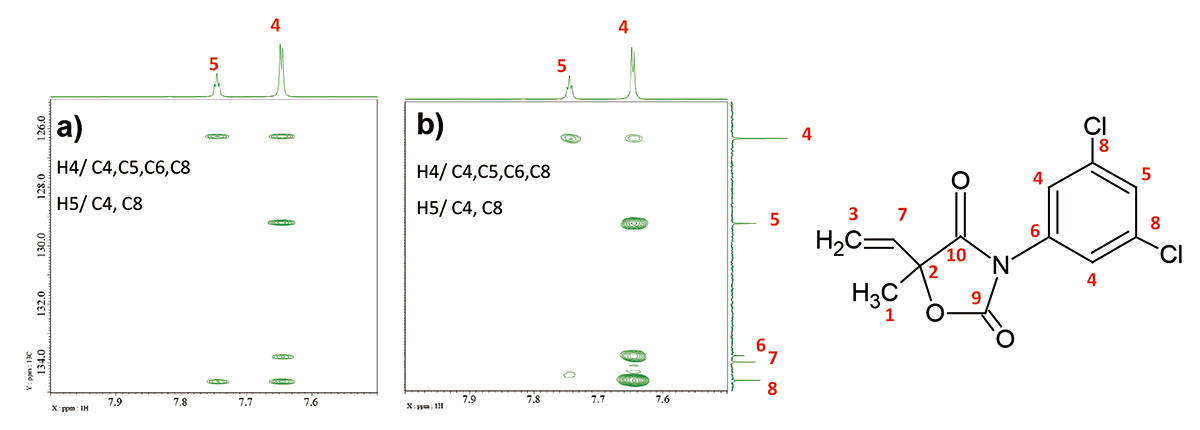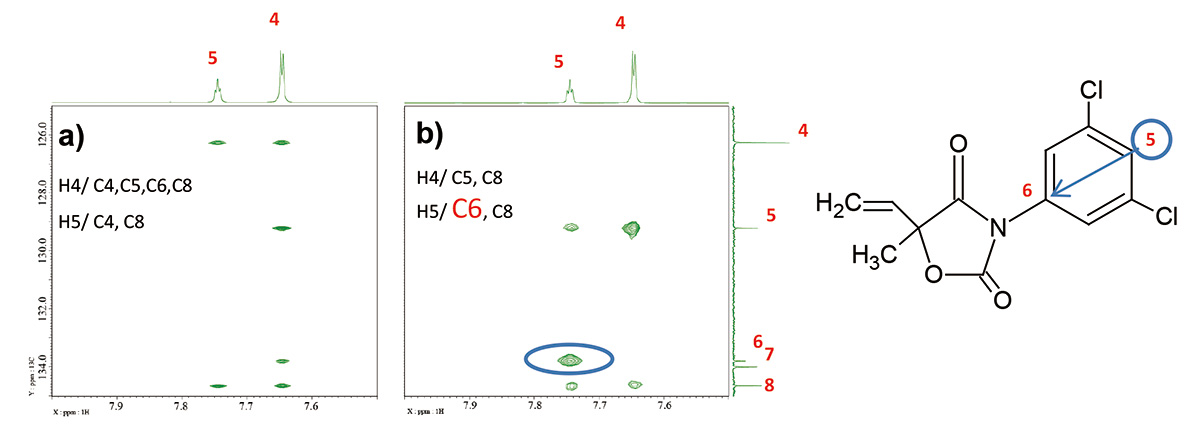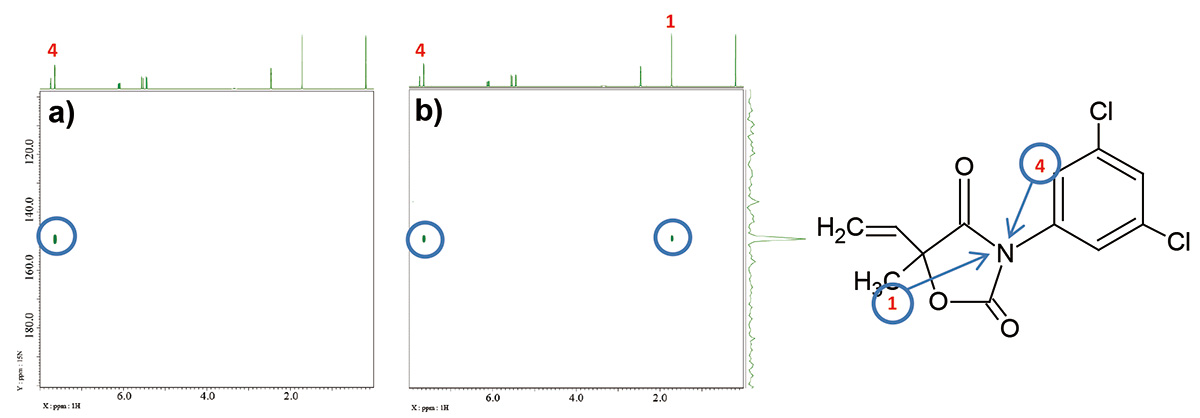How to use LR-HSQMBC: Observation of very small couplings
NM200014E
The HMBC (Heteronuclear Multiple Bond Correlation) experiment is the most widely used technique for observing heteronuclear long-range correlations. HMBC mainly observes 2- and 3-bond correlations; however, 4-bond correlations can sometimes be observed as well. The correlations observed in an HMBC spectrum strongly depend on the matching of the transfer delay used in the experiment with the long-range heteronuclear J-couplings that exist in the molecule.
HMBC correlation signal is anti-phase as shown in Fig. 1a), however, this is not usually observed in HMBC spectra, because HMBC data are usually processed in absolute-value mode. However, this anti-phase nature of HMBC signal may lead to partial cancellation and signal reduction for very small long-range couplings, as shown in Fig. 1b).
To overcome this problem, the D-HMBC (Decoupled HMBC) ※1 and LR-HSQMBC (Long-Range Heteronuclear Single Quantum Multiple Bond Correlation) experiments were developed. In D-HMBC and LR-HSQMBC, signals appear as in-phase doublets in the direct (F2) dimension, as shown in Fig. 2a. Therefore, there is no signal cancellation in the case of very small couplings, and heteronuclear decoupling can also be applied in order to increase sensitivity. For these reasons, the experiments offer higher sensitivity than the traditional HMBC experiment.
On the other hand, the D-HMBC experiment suffers from signal splitting by JHH in the indirect dimension, which reduces the resolution of the spectrum. Here we will introduce the LR-HSQMBC experiment in detail because of its superior resolution.

Fig. 1: Signal pattern of HMBC
a) Large coupling, b) Small coupling

Fig. 2: Signal pattern of LR-HSQMBC
a) Large coupling, b) Small coupling
Fig. 3 shows the pulse sequence diagram of LR-HSQMBC experiment. To observe heteronuclear long-range correlations that are difficult to observe with HMBC, nJXH should be set to a small value, such as 2 Hz. It is a standard experiment from NMR software Delta V.5.2.0. The name of the pulse program is lrhsqmbc.jxp.

Fig. 3: Pulse sequence of LR-HSQMBC
Reference of LR-HSQMBC
R. Thomas Williamson, Alexei V. Buevich, Gary E. Martin, Teodor Parella, J. Org. Chem.2014, 79, 3887-3894.
R. Thomas Williamson, Alexei V. Buevich, Gary E. Martin, Tetrahedron Letters 55 (2014) 3365-3366.
Here we compare the aromatic region of 1H-13C HMBC and 1H-13C LR-HSQMBC spectra recorded on a sample of vinclozolin. In general, 3JCH couplings are large on aromatic rings, and hence correlation signals arising from 3-bond couplings are of high intensity.
1H-13C HMBC
Fig. 4 shows two results obtained with the HMBC experiment. Although, the long-range delay was optimised to 8 Hz (a) and 2 Hz (b), respectively, the structural information obtained from the spectra is the same. In both cases, all 2-bond and 3-bond correlations of protons H4 and H5 were observed.

Fig. 4: Expansions of HMBC: a) 8 scans, long_range_j: 8 Hz , b) 32 scans, long_range_j: 2 Hz
1H-13C LR-HSQMBC
Fig. 5 shows two results obtained with the LR-HSQMBC experiment. The spectrum in a) shows the same result as HMBC in Fig. 4a). However, the H5/C6 correlation in the blue oval arising from 4JCH was not observed with HMBC in Fig. 4b). The coupling constant between H5 and C6 is 2.2 Hz. While HMBC is an absolute-value experiment, LR-HSQMBC is a phase-sensitive experiment, and hence the number of scans in LR-HSQMBC was set to half of scans in HMBC in order to set the same experimental time in both experiments.

Fig. 5: Expansions of LR-HSQMBC: a) 4 scans, long_range_j: 8 Hz, b) 16 scans, long_range_j: 2 Hz
Sample: 5mg Vinclozolin in DMSO-d6
Instrument: JNM-ECZ500R, ROYALPROBE™ HFX
Since 1H-15N long-range couplings are similar in magnitude to 1H-13C long-range couplings, the LR-HSQMBC experiment also has potential to improve the detection of 1H-15N long-range correlations. As 3JNH couplings have a larger variation than 3JCH, the entire range of 3JNH couplings cannot be completely covered with a single HMBC experiment. It is worth mentioning that structure elucidation of compounds containing nitrogen strongly relies on 2D 1H-15N correlation experiments, because the direct detection of 15N is very challenging at natural abundance.
1H-15N HMBC and 1H-15N LR-HSQMBC
Fig. 6 shows two results obtained with the HMBC and LR-HSQMBC experiments. The only H4/N correlation can be observed in the 1H-15N HMBC spectrum a). On the other hand, H4/N and H1/N (4JNH) can be observed in the LR-HSQMBC spectrum b). The size of H4/N coupling is 4.2 Hz and the size of H1/N coupling is 1.5 Hz.

Fig. 6: a) 1H-15N HMBC, 32 scans, long_range_j: 2 Hz , b) 1H-15N LR-HSQMBC, 16 scans, long_range_j: 2 Hz
Sample: 5mg Vinclozolin in DMSO-d6
Instrument: JNM-ECZ500R, ROYALPROBE™ HFX
Features and main application of each experiment
The principal features of heteronuclear long-range correlation experiments can be summarised as follows:
At first, HMBC correlations should be used for analysis. If you cannot differentiate between 2JCH and 3JCH HMBC correlations, consider H2BC or 1,1-ADEQUATE. H2BC is suitable for proton-rich samples, while 1,1-ADEQUATE can also be used for proton-deficient samples.
If the structural information obtained from HMBC is inadequate for analysis due to many quaternary carbons and hetero atoms in the molecule, then consider LR-HSQMBC.
HMBC--- Observe mainly 2JCH and 3JCH correlations.
H2BC※2--- Selectively observe 2JCH correlations. Correlations of quaternary carbon atoms cannot be observed.
1,1-ADEQUATE※3--- Observe 1JCH and 2JCH correlations. Correlations of quaternary carbons can be observed. Very low sensitivity.
LR-HSQMBC--- Observe correlations close to the set J-value. However, it is difficult to determine the number of chemical bonds between the interacting partners.
Reference
※1 Kazui Furihata, Haruo Seto, Tetrahedron Letters 1995, 36, 2817-2820.
※2 JEOL Application note NM070003E.
※3 JEOL Application note NM160002E.
- Please see the PDF file for the additional information.
Another window opens when you click. 
PDF 812.5KB
SEARCH APPLICATIONS
Related Products
Solutions by field
Are you a medical professional or personnel engaged in medical care?
No
Please be reminded that these pages are not intended to provide the general public with information about the products.
